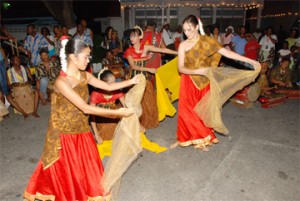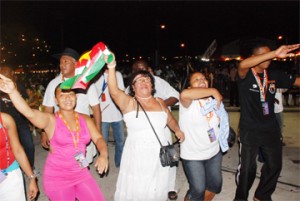When Suriname heard Guyana was hosting Carifesta X its cultural gurus were immediately propelled into action as they wanted to show some “neighbourly love” by bringing the largest contingent to the culture and art celebrations.
 It did. By Thursday when this interview was conducted, several performers who had already done their part had departed, leaving 190 participants behind, one Artistic Director of the group, Henk Tjon, told The Scene. The contingent could have been even larger, “but because of budgeting we had to leave some behind.
It did. By Thursday when this interview was conducted, several performers who had already done their part had departed, leaving 190 participants behind, one Artistic Director of the group, Henk Tjon, told The Scene. The contingent could have been even larger, “but because of budgeting we had to leave some behind.
“We just had to bring a big contingent. It is Guyana our neighbour and we wanted to put on a good show for our neighbour,” Tjon said, when he and the head of the country’s delegation, Dubois Lucien took time out to chat with us.
The delegation was described as one that is a reflection of the country’s “Multi – en Inter – Cultural Society” and its participation was in the context and the spirit of Suriname’s national celebrations and of certain aspects of national and religious holidays. The holidays symbolise freedom, dignity and unity of the country’s “harmonious society.”

Tjon also told us that in 1972, he was part of the delegation that came here to the first ever Carifesta and was part of a contingent of 250. “That was our biggest contingent ever and this is our second biggest, we have never taken any such large contingent to other celebrations,” he said.
Suriname stamped its authority as the contingent that would outshine any other from day one. It was the Suriname drummers who kept the other delegates energised as they waited for the start of the opening ceremony.
No other delegation could have taken up home at the Ocean View Hotel quite the way Suriname did. Why? The participants took up all the rooms! They even placed their own welcoming sign outside the hotel.
Country presentation
For the country presentation, which was held last night, Tjon said all of the different ethnic groups would have been on display. “It would be like one large cultural mosaic will be presented,” he said. “There would be many different dances and music styles from the African people, from the Indian people, from the East Indian people, from the Indigenous people, from the Indonesian people, from all the ethnic groups.”
‘Brucka day’
One of the performances of the group was done at the Amerindian village in Sophia on Wednesday night. The performance was called Epekodono and was done by the Indigenous people. It is usually an all-night affair, from 6 pm to 6 am and is properly known as ‘brucka day’ in Suriname because it concludes at sunrise. Arawaks and Caribs from Suriname were expected to team up with Amerindian tribes in Guyana for the performance, in which the indigenous people honour and remember their ancestors, in particular those indigenous tribes of the Caribbean islands and the mainland of the Americas. “During this celebration of diversity in unity we personalise our country, Mother Suriname, our mother’s womb, symbolically exposed by the woman, as an exponent of life and our culture,” Tjon said.
The Surinamese were also involved in the youth village held at the National Park where they embraced the youths of the Caribbean “literally and figuratively and created a bond that will last forever.” A Maroon art exhibition was also donated to Guyana’s museum.
Bugbears
And while the two gentlemen said their delegation enjoyed Guyana as the country’s hospitality is not matched by many countries, there were some things they found not up to scratch. “But we enjoyed Guyana, we love the people and the people love us,” Lucian said. Some of the positives were good media coverage, updated programming, lots of facilities, good location for the grand market, security, hospitality of the liaison officers and the fact that “everyone is in a Carifesta mood.”
However, the sound and lights at the National Stadium during the opening ceremony were “very poor” also the sound at the grand market. The delegation complained about the time it was given during one of its presentations when other countries were given more time.
The Surinamese also wanted to know how many countries participated, what were the reasons for some countries not participating and whether the name Carifesta should be kept when “the presence and influence of Brazil is visible on the stages.” Brazil, like some of the other countries including Indonesia, is not part of the Caribbean.





